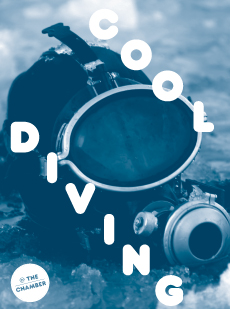




| Home | Features | Club Nights | Underwater Pics | Feedback | Non-Celebrity Diver | Events | 8 August 2025 |
| Blog | Archive | Medical FAQs | Competitions | Travel Offers | The Crew | Contact Us | MDC | LDC |

|

|
 
 |
  ISSUE 15 ARCHIVE - AT THE CHAMBERDr Trevor OxleyCool Diving or just Hypothermia?Recently I was at an inland diving site. The water temperature was about 7°C, but the wind chill made it feel significantly colder. I was looking out over the water thinking about the origins of the universe when, just at the point I thought I had the perfect explanation to the question, a couple of divers came out of the water. As they slowly made their way towards a small wall to take off their kit, I thought their faces reminded me of pieces of fine china. One face was porcelain white; the other was that of classical Wedgewood – blue. De-kitting was slow and looked uncomfortable, conversation was punctuated with periods of uncontrolled teeth chattering. It was that scene which prompted me to write this article. Being mammals we need to have, or maintain, a relatively stable body temperature of around 37°C plus or minus 1°C. When our deep body temperature falls below that we need to find ways to raise our body temperature back into that range. We can do this in a variety of ways, for instance, by shivering or putting on clothes. If we are unable to do that and our body temperature falls below 35°C, then we become hypothermic. Water is a good conductor of heat and has a high specific heat capacity. This makes heat conservation quite a difficult thing to achieve, and it becomes more difficult with longer and deeper dives, inadequate clothing protection, and in some cases, using different diving gases. As the diver becomes more hypo-thermic, confusion and disorientation, with slowing of mental processes occurs, with impairment of decision-making skills and slowing of motor skills occurring quite early in the process. As the situation worsens the above problems become more complex with changes in electrical conduction of the heart and respiratory system. Below is a summary of the changes seen with increasing hypothermia: MILD HYPOTHERMIA
MODERATE HYPOTHERMIA
SEVERE HYPOTHERMIA
SO, WHAT DO YOU DO IF YOU COME ACROSS SOMEONE WITH HYPOTHERMIA?Always remember to first assess the dangers and risks involved. Make sure you don’t become a casualty of the cold yourself. It’s very easy in the heat of the moment (excuse the pun) to become wet and cold. Exhaustion is a common problem, especially if this is in a remote area with little help. As tempting as it is, don’t donate your own protective clothing, even to the casualty you are trying to help. Get help! Next is ABCDE. I’m sure that over the winter months you’ve all had the opportunity to review and practice your first aid skills and will seamlessly start with basics first aid management, by assessing the airway, breathing and circulation. Having said that, it is quite difficult in cases of hypothermia to assess breathing and pulse. You might need to try and detect the pulse for at least one minute in moderate to severe cases of hypothermia before starting chest compression, and if at any time you do detect pulse then chest compression should be stopped. Basic resuscitation should be continued until further help arrives. It is worth noting that even if the diver might appear to be unresponsive; it is always worth persisting with the resuscitation until the diver can be evacuated to hospital. Keep the diver horizontal at all times and preferably raised from the ground on some insulation. Remove any wet clothing carefully, and dry the skin gently. Keep the diver warm in blankets, a sleeping bag or space blanket, and do your best to protect them from the effects of wind chill. If the temperature is particularly cold it might be worth considering a scarf over the mouth and nose, which will help warm the airways, but it is important to carefully monitor the patient’s breathing and pulse rate regularly. Oxygen may be beneficial, but it’s probably best not to use it if the cylinder is very cold. I hope the short summary above will act to remind you that the water temperature can cause problems, particularly for those who are young, old or those with certain medical conditions. However, the main point I’d like to reinforce is that prevention is better than cure. Always assess the risks first. Wear the right level of protective clothing to suit the conditions. Consider shortening the length of the dive time or the depth to suit the water temperature. Remind yourself of the signs and symptoms associated with hypothermia. Keep your first aid skills up-to-date. Have a look at some of the sites on ice diving. Although the environment looks extreme, and it is, the water temperatures in such areas are often no colder than those in the UK in the winter. Looking at the precautions that experienced ice divers take will give a good idea of how we should be thinking about how we approach diving in the colder parts of the year. I hope this doesn’t seem like too much doom and gloom; it’s not my intention to throw anyone into a great fit of depression, thinking that you might come a cropper every time you dive in cold water. Cold water diving, as I’m sure many of you know, can be very good. It just needs a little forethought. Swapping your favourite all-in-one Lycra suit for another made of rubber can make all the difference. Happy diving. Previous article « Underwater Photography Next article » Rob's World: How To Survive a Dive Show Back to Issue 15 Index |